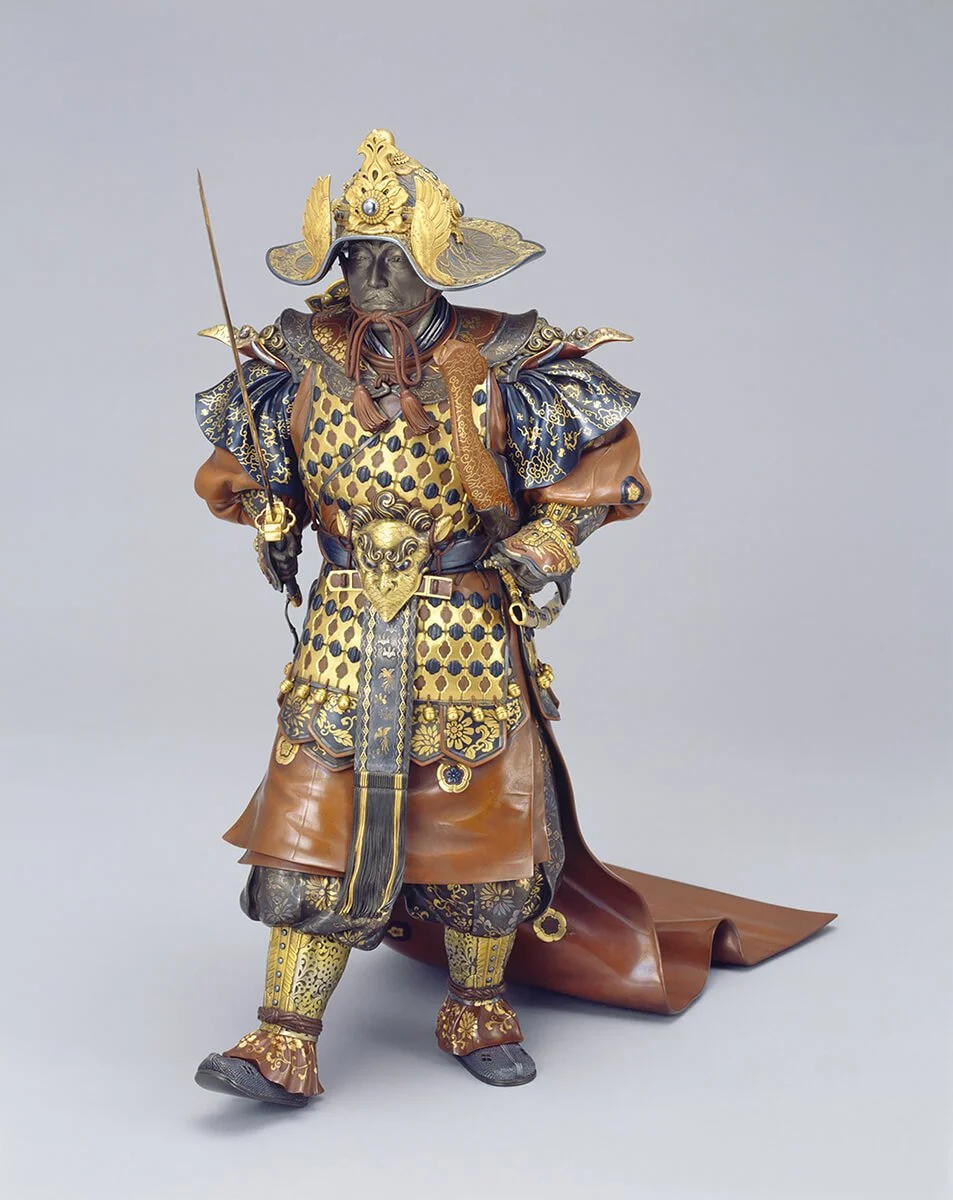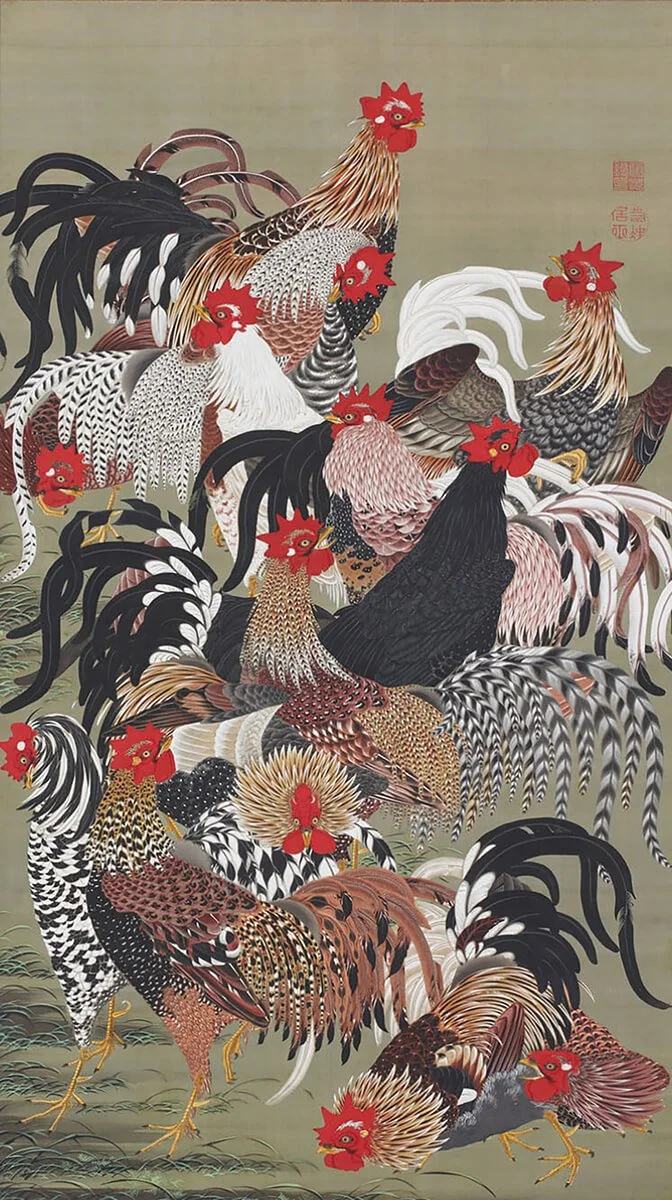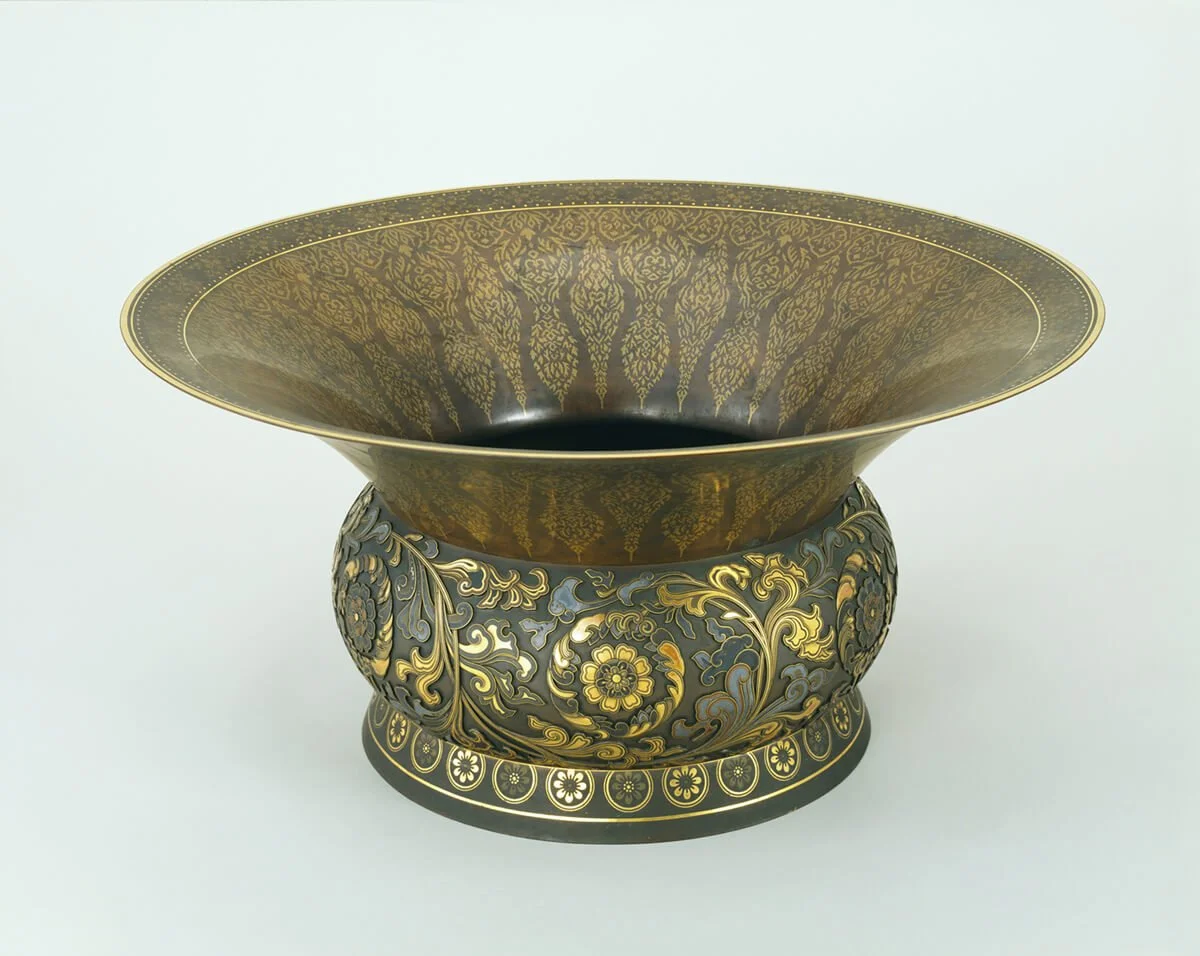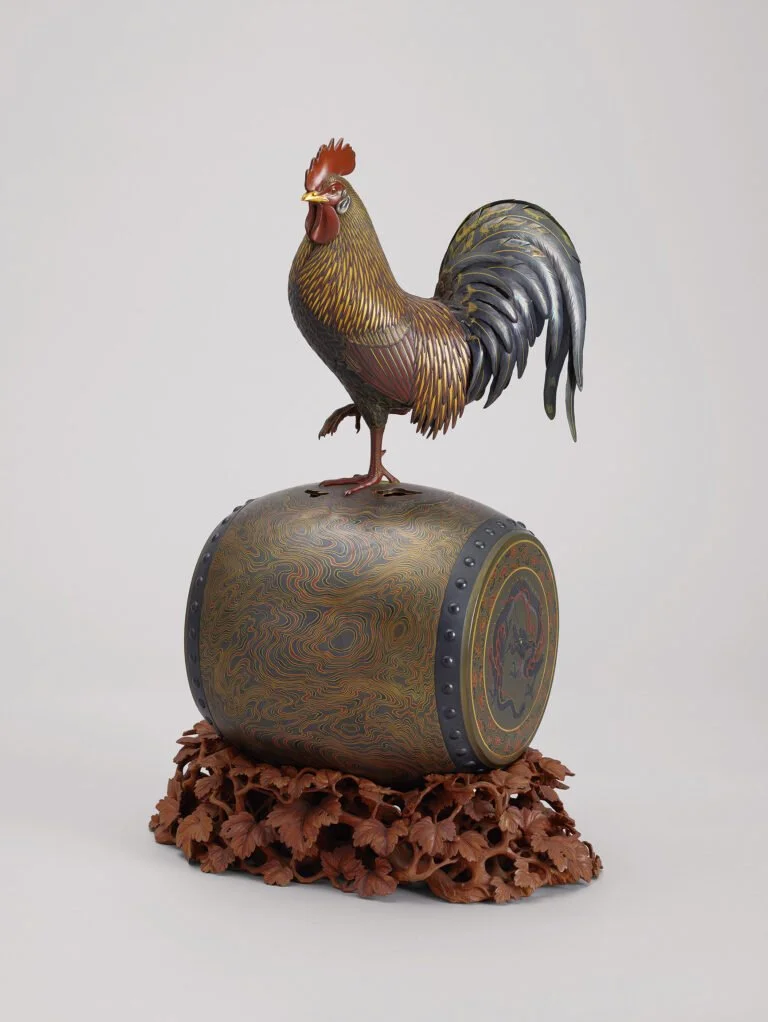Maeda’s Cultural Alchemy: Crafting Kaga Heritage in the Edo Period
This fall, the city of Kanazawa invites us to explore the profound influence that culture has in shaping the status and identity of a region in a special exhibition, The Imperial Household and Ishikawa: Brilliance of Elegant Beauty.
Sense of Wander: ★★★★★
Made at the request of the Ministry of the Imperial Household, Taiheiraku Figurine is a masterpiece by Unno Shomin (1844-1915), an imperial artist who skillfully employed casting, forging, engraving and zogan inlay to breathe life into this extraordinary creation. The piece was exhibited at the Paris World's Fair in 1908. Image courtesy of Sannomaru Shozokan.
KANAZAWA, Japan — Art and craft enthusiasts are likely familiar with Kyoto, Japan's ancient capital, where traditions and heritage are part of the city’s everyday life. But beyond Kyoto lies Kanazawa, hailed as the epicenter of traditional Japanese crafts — an unmissable destination for those seeking an alternative cultural experience.
Known as the city of kogei, or crafts, Kanazawa stands as a bastion of artistic excellence where traditional crafts thrive in abundance. Visitors delving into the art of gold leaf, lacquering, dyeing, embroidery, and pottery may be captivated by the city’s rich cultural tapestry. But what often goes unnoticed is the profound influence of the Maeda clan, contemporaries of the Tokugawa shogunate in Edo (present-day Tokyo), whose patronage and support laid the foundation for Kanazawa's enduring cultural legacy.
This fall, a special exhibition, The Imperial Household and Ishikawa: Brilliance of Elegant Beauty, jointly hosted by the Ishikawa Prefecture Museum of Art and the National Crafts Museum in Kanazawa illuminate the pivotal role that the Maeda played in the renaissance of Japanese arts and crafts during the Edo period (1583-1868), shaping the region’s cultural landscape as we know it today.
Scattered Fans by Tawaraya Sotatsu. Dated to the 17th century. Image courtesy of Sannomaru Shozokan.
Maeda: The Alchemist Behind Kaga’s Cultural Renaissance
Kaga Domain is among the 250 relatively autonomous domains under the shogun's authority in Edo Japan. Encompassing present-day Ishikawa and Toyama prefectures, Kaga was governed by the Maeda, a wealthy samurai family that held feudal lordship for nearly three centuries.
Kaga Domain was the wealthiest, with its leaders holding high-ranking positions in the shogunate despite their distance from the capital. Wealth, during that time, was gauged by the amount of rice and other crops a domain could yield, measured in units of dry, unmilled rice known as koku, equivalent to about 180 litres. Kaga's official yield of one million koku (all referred to as hyakumangoku) surpassed that of any other domain, a point of immense pride still echoed in Ishikawa, especially in connection with haute cuisine and luxury crafts.
Wary of their wealth being seen as a threat to the shoguns’ rule, the Maeda employed strategic measures by redirecting their resources into cultural pursuits. A notable instance is the samurai’s engagement in ayu (sweetfish) fishing to enhance their physiques and reflexes. This practice, originally a privilege for the warrior class, was later adopted by the general public, leading to the development of Kaga fly fishing lures, or “Kaga Kebari” that are distinctive for the absence of hooks.
Calligraphy by Emperor Go-Mizunoo that reads Nin, meaning “endurance”. Image courtesy of Maeda Ikutokukai Foundation.
In an exhibition that showcases the cultural pinnacle of a domain governed by some of the wealthiest individuals, one would anticipate the narrative to begin with luxurious objects that exemplify Kaga domain’s zenith. But, unexpectedly, I was met with a modest calligraphy bearing the character Nin, signifying “Endurance”.
In 1615, the Edo shogunate took decisive measures to assert control over the imperial household, prompting Emperor Go-Mizunoo (r.1611–1629) to abdicate the throne in despair. After stepping down, the emperor immersed himself in sophisticated cultural pursuits as a way to channel his resentment towards the shogunate government, undertaking projects such as the Shugakuin Imperial Villa located on the outskirts of Kyoto.
Maeda Toshitsune (r.1603–1639), the third lord of the Kaga Domain and a subordinate of the shogunate, learned from Emperor Go-Mizunoo the importance of establishing one's dignity through cultural excellence. He initiated the so-called “cultural policy”, emphasising cultural and artistic influence over political and military might.
During the 17th century, the Maeda lords invited some of the finest craftsmen from across Japan to reside in Kanazawa, offering them generous stipends. This initiative gave birth to a thriving artistic culture in the region, fostering a legacy that resonate to this day.
The Maeda’s emphasis on cultural prowess, as opposed to political or military dominance, became a reality through the act of “perseverance” (nin), a principle highlighted in this calligraphy bestowed to Maeda Toshitsune by the emperor. This hanging scroll is among the many treasures in the Maeda Ikutokukai Collection, renowned for preserving the writings, art, and crafts passed down in the Maeda family.
Ishikawa’s Bond with the Imperial Household
While local arts and crafts serve as living testimonials to a region's identity, there's arguably no better place to grasp the pinnacle achieved by artisans and craftsmen than by delving into the imperial collection. Often regarded as a civilisation’s treasure trove, the imperial treasures encapsulate and distill the essence of culture across time.
What sets The Imperial Household and Ishikawa apart is its inclusion of masterpieces from the Museum of the Imperial Collections, Sannomaru Shozokan (三の丸尚蔵館), in Tokyo — home to a proud collection of 6,100 works passed down through generations within the imperial household, spanning from ancient times to the present day.
With a display of 120 works, including national treasures and important cultural properties, the exhibits share profound connections with Ishikawa, the very location where the exhibition is held; they encompass offerings presented to the imperial household by the Maeda family, creations by artisans working for the imperial family, as well as living national treasures from Ishikawa.
The bond between Ishikawa and the imperial family are traced through the Maeda, a connection strengthened through the marriage of Fuhime (daughter of Maeda Toshitsune) to Prince Hachijo Toshitada. Throughout their union, the Maeda often gifted items to the imperial household.
Listed as National Treasure, Ito Jakuchu’s Flora and Fauna - Painting of Flock of Chickens presents a lively gathering of roosters competing for attention. Image courtesy of Sannomaru Shozokan.
While we've seen exhibitions featuring Sannomaru Shozokan’s treasures before, something special is in the air — this is the very first time the imperial collection joins forces with two prestigious museums in Kanazawa: the Ishikawa Prefectural Museum of Art and the National Crafts Museum.
Among these treasures is Colourful Realm of Living Beings, a masterpiece by Ito Jakuchu (1716-1800). Originally donated to the Shokokuji temple as an expression of the artist’s religious commitment, this painting found its way to the imperial household during the Meiji era (1868—1912), a time when the temple grappled with financial challenges. With his brush, Jakuchu breathed life into a gathering of brilliantly-hued roosters, orchestrating a visual symphony that feels almost like a spirited competition. Each feathered contestant seems to vie for the viewers’ attention, creating a dazzling spectacle of colour and form.
A remarkable exhibit is a calligraphy piece by none other than Wang Xizhi (317-420), hailed as the “Sage of Calligraphy” who is revered for elevating the art form to new heights. A generous gift to the emperor in 1910 by Maeda Toshinari, Hanging Scroll with Traced Copy of Letter Known as Sangluantie serves as a portal into Wang Xizhi’s artistic brilliance, a legacy that continues to resonate after a thousand years since the calligrapher’s passing.
Among the items gifted to the imperial household are exquisite metalwork items crafted by Doki Kaisha (Co.), later renamed the Kanazawa Doki Kaisha (Co.). Notably, a vase on display stands as a testament to the unparalleled artistry of Doki Kaisha (Co.). This awe-inspiring creation, adorned with floral and arabesque patterns in zogan inlay, once graced the halls of the Imperial Palace during the Meiji era. Its rim, adorned with horizontal gold inlays, weaves a mesmerising tapestry of textures on the base metal. It took my breath away when I first laid eyes on this creation — the precision of the zogan inlay, evoking the tactile quality of fine fabric, is unlike anything I’ve seen.
Crafted in 1891 by Kanazawa Doki Gaisha Co., this vase is a mesmerizing dance of contrasts — the vessel's rim is delicately inlaid with hairline patterns that evoke the tactile quality of fine fabric, while its body boasts a bold arabesque pattern adorned with opulent displays of gold and silver inlay. Image courtesy of Sannomaru Shozokan.
The establishment of osaikusho workshops stands as a testament to the cultural policy championed by the Maeda lords. Initially tasked with managing, repairing, and resupplying weapons and armour for the feudal and shogunate government, these workshops later evolved into centers of arts and crafts with the influx of master artisans from Edo and Kyoto.
What best exemplifies the flourishing arts and crafts in the Kaga Domain at the time is Hyakko Hisho, or the “Encyclopedia of Various Skills of Decorative Arts”. Hyakko denote various types of crafts or artisan skills, and hisho means to compare and contrast.
Maeda Tsunanori (r.1645–1723), the fifth lord of the Kaga Domain, responded to the growing interest in natural history during his time by spearheading numerous projects Among these, Hyakko Hisho was compiled, a title bestowed by the lord himself."
The collection spans ten boxes, housing over 2000 individual items categorised by type. These included paper, mounted karakami paper (craft paper imported from Tang China), covers for scrolls and writings, coloured lacquer, leather, fabrics, fine patterns, bamboo, wood, dyes, metal fittings, and much more. This compilation of craft techniques from the early to mid Edo period serves as an invaluable resource, offering a profound insight into the breadth and depth of Kaga’s artistic achievements at the time.
Metal fittings in the shape of a flower basket, from Hyakko Hisho (Encyclopedia of Various Skills of Decorative Arts). Image courtesy of Maeda Ikutokukai Foundation.
Metal fittings in the shape of a bird cage, from Hyakko Hisho (Encyclopedia of Various Skills of Decorative Arts). Image courtesy of Maeda Ikutokukai Foundation.
A captivating piece from the Sannomaru Shozokan collection features a rooster perched atop a kanko drum, which, intriguingly, serves as an incense burner. Originally designed to provide a means for people to express their protestations or complaints about the sovereign, the drum depicted in this unique object has seen little use due to the prevailing peace over the land. As a result, a rooster has found a tranquil perch on the drum, with ivy growing underneath.
Despite being forged in metal, the rooster's feathers exude an unexpected softness and fluffiness, creating a curious contrast with the inherent hardness of the material. The feathers are delicately inlaid with gold wires, adding a touch of detail. The drum's rounded body showcases intricate metal inlays, as if mimicking the aesthetic of mokume-gane, a traditional Japanese metalworking technique known for producing distinctive patterns reminiscent of natural wood grain.
Crafted by Yamao Jikichi (1862-1923) in 1900, this exquisite incense burner depicts a rooster perched atop a kanko dum. Image courtesy of Sannomaru Shozokan.
A close-up view at Yamao Jikichi’s masterpiece reveals the intricate gold inlays adorning the surface of the kanko drum.
Legacy of Kaga Culture Lives On
Much like the Medici family that ushered in the Italian Renaissance after the Middle Ages, the Maeda's patronage fueled the development of many of Ishikawa's prominent crafts. Their promotion of the tea ceremony gave rise to the esteemed Ohi ware, exclusive tea bowls crafted solely by heirs of the Ohi family. Noh and Kabuki theaters thrived under their support, contributing to the vibrant landscape of Kaga culture. Under the Maeda’s patronage, arts, crafts, cuisine, and culture flourished, coalescing into what is known as "Kaga culture”.
In 1868, the osaikusho workshops were abolished but Ishikawa Prefecture, taking advantage of this rich cultural heritage, leveraged it in its export industry, and proudly showcased its products at domestic and international expositions.
In 2009, Kanazawa earned the distinction of being a UNESCO City of Crafts and Folk Art, which eventually led to the relocation of the National Crafts Museum from Tokyo to Kanazawa in 2020.
Today, as the echoes of the Maedas and their samurai linger amid the remnants of Kanazawa Castle and the historic Nagamachi Samurai district, skilled artisans continue their craft within the vicinity of what was once the heart of the Kaga Domain. Boasting the highest concentration of important intangible cultural properties, including living national treasures, Kanazawa stands as a cultural haven, preserving traditions in the heart of Japan. And with a swift 3-hour train ride from both Kyoto and Tokyo, this vibrant cultural hub is easily within reach for those seeking a journey through Japan's artistic heritage.
Culture shapes the way we see the world, and in doing so, it shapes the world itself. It is a potent force that can unite or divide, inspire or oppress, and ultimately define the trajectory of civilisation.
Tips for wanderer — Don’t worry if you missed the exhibition. While strolling through the city’s renowned Kenrokuen Garden, be sure to visit the Ishikawa Prefectural Museum of Traditional Arts and Crafts next door, where examples of local arts and crafts are proudly on display. The enduring legacy of Kaga culture, shaped by the Maeda family, lives on — in the museums, galleries, and shops throughout Kanazawa.
The Imperial Household and Ishikawa: Brilliance of Elegant Beauty was on view at the Ishikawa Prefectural Museum of Art and the National Crafts Museum in Kanazawa from October 14 to November 26, 2023.









